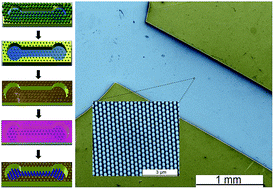Fabrication of well-ordered silicon nanopillars embedded in a microchannel via metal-assisted chemical etching: a route towards an opto-mechanical biosensor†
Abstract
Ordered nanopillars have been used as a smart configuration to design and fabricate localized surface plasmon resonance (LSPR) sensors. Importantly, these nanostructures can be integrated within microfluidic channels as a novel opportunity to enhance the response of biosensors and also to control the fluid flow by modifying the wettability surface of the walls. In this work, we demonstrate a large-scale and low-cost nanofabrication methodology that integrates the fabrication of silicon nanopillars (SiNPs) inside a microfluidic channel. The strategy is based on placing a catalytic gold layer patterned with nanoholes inside a SU-8 microchannel, by combining nanosphere lithography, reactive ion etching, and e-beam gold deposition, to control the area, separation distance and diameter of the nanostructures. The height of the SiNPs strongly depends on a well-controlled metal-assisted silicon etching protocol. We demonstrate experimentally that the design and the cleaning of the catalytic gold mesh using ultraviolet ozone strongly affect the etching rate for the formation of large-surface-area nanopillars. Our results explain the fast fabrication of hexagonal arrays of SiNPs embedded in a microfluidic channel with varying aspect ratio from 2 to 7 and separation of 300 nm and 400 nm, respectively, which has important implications for the achievement of new optomechanical biosensors.



 Please wait while we load your content...
Please wait while we load your content...